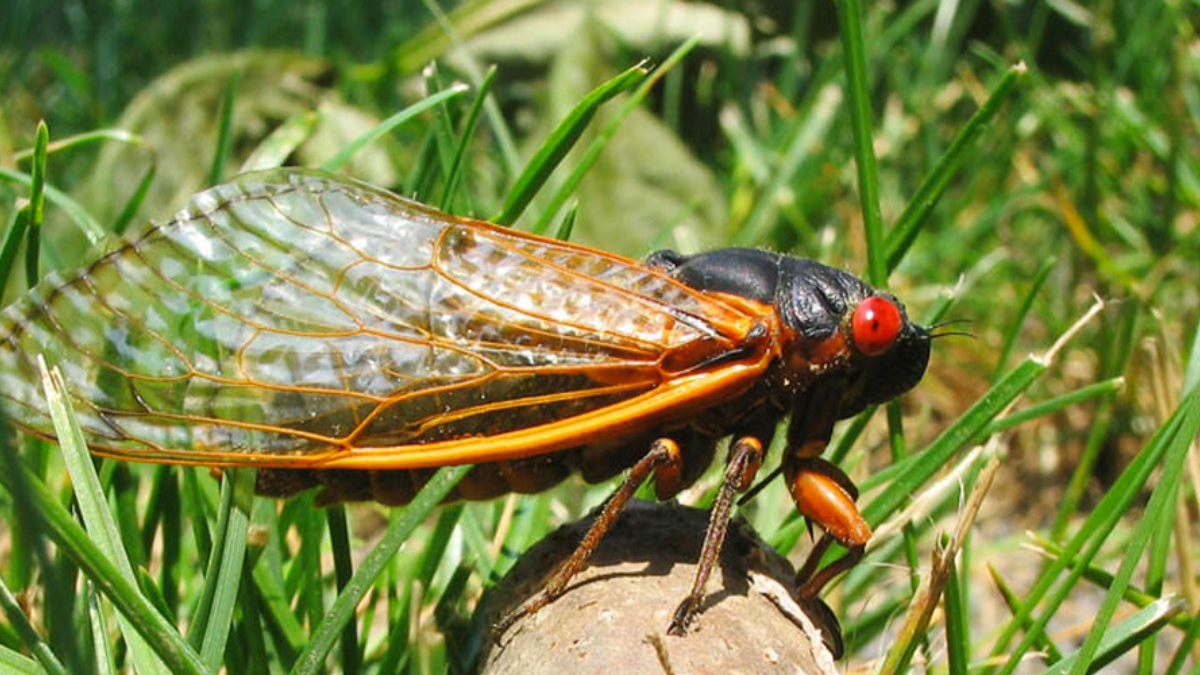In the spring of 2016, a massive brood of cicadas emerged in northern West Virginia after 17 years underground. The event prompted one West Virginia University (WVU) professor to study the composition of their wings.
The cicadas appeared in Maryland, New York, Ohio, Pennsylvania, Virginia and West Virginia. America, it turns out, is the only country in the world where periodic cicadas remain underground for so long.
These periodical cicadas don’t spend all those years hibernating. Instead, they remain alert and highly active in their wingless nymph forms, busy excavating tunnels and feeding on sap from tree roots.
When broods of cicadas emerge from underground, backyards turn into an undulating chorus of millions of bugs. This loud noise is exclusive to the males, originating in sound boxes in their abdomens. The males use it in synchronized unison to establish territory and attract females.
About six weeks later, the chorus is silenced. The adult cicadas die off, leaving eggs laid by females ready to hatch new nymphs that burrow underground for the next 13 or 17 years to repeat the cycle.
Terry Gullion, professor of chemistry in the WVU Eberly College of Arts and Sciences in Morgantown, remembers the event in 2016 by the sheer number of the insects covering his deck.
“I was just looking at them, of course I had all these dead cicadas laying on my deck and everything,” Gullion said. “So I thought maybe it would be interesting to look at their wings using the methods I’ve been using for other chemical type problems.”
Gullion’s study of insect wings turned into a research project. The emergence event provided plenty of samples at first but finding enough insect wings to study became more of a challenge, as the project expanded.
Gullion said the wings of cicadas were easier to handle.
“Fortunately for us, they’re fairly large wings so they were easy to dissect,” Gullion said. “We dissect the membrane from the wing just using a razor and a microscope, so it’s quite tedious.”
Previous studies have mostly focused on exoskeletons of insects with little attention paid to the actual chemical composition of their wings.
“If you look at an insect it looks like a series of veins which encapsulate, or compartmentalize these very thin membranes, often very clear,” Gullion explained. “And it turns out the membranes are super thin, only microns thick, they’re thinner than a human hair.”
As Gullion and his team continued to examine the wings, they discovered the wing membranes were not composed primarily of protein but were far more complex than previously thought.
Gullion said previous studies used optical microscopy, a technique used to view wing samples through the magnification of a lens using visible light. He said, however, that technique failed to establish their full composition.
Using nuclear magnetic resonance, Gullion was surprised to learn that, despite their apparent fragility, the membranes of insect wings turned out to be unusually strong and durable.
“I mean if you just think, in North America, of the Monarch butterfly – it flies all the way from Canada down to Mexico,” Gullion said. “We think of these things as fragile, but obviously they’re not.”
Gullion’s research led to the discovery that insect wings are composed of the highly resilient molecule known as chitin.
“It’s the second most abundant biopolymer on the planet, only behind cellulose, which of course is the building block of a lot of plants,” he explained. “If you look at lobster claws, crab shells, well that’s predominantly chitin, a very hard material and very protective.”
Gullion is seeking funding for the next stop of his research: determining the molecular structure of wings, which he said could lead to further advances in technology using nature as a guide.
The answers may help shed light on how insects endure tremendous amounts of forces while remaining thin and flexible.
“What drives some of the interest in this is how do you have such a very thin material that is very lightweight, yet very strong,” Gullion said. “So in a sense, nature can help guide you to make a material that has similar properties.”
Once a clearer picture of the molecular structure of wings is known, Gullion envisions a variety of applications, including the agriculture industry. One includes pesticides that target or weaken specific species but don’t harm beneficial insect pollinators like bees.
The technology could even extend to the application of micro aerial vehicles or drones for use in search and rescue situations like earthquakes.
“If you could imagine in the future very small things that can fly between the rubble and take a visual of what’s going on,” Gullion hypothesized, “that could really help a lot of people, there’s a lot of possibilities one could envision.”
Gullion said his research is evidence there’s a lot more to be learned from nature and the importance of insects that have been flying for millions of years.
“For every human being on the planet, there’s a hundred million insects,” Gullioin said. “Maybe not in my backyard, but if you think that, in jungles and in the tropics, or even when you’re out in the forest, it’s just mind blowing the numbers and quantities and variety of insects.”
Gullion said his research helped him understand that taking insects for granted will not bode well for humankind in the future. In addition to aerating the soil, pollinating blossoms, and helping control plant pests, they recycle nutrients back into the soil.
“A famous naturalist Edward Osborne Wilson pointed out that if all humans disappeared from the planet tomorrow, basically what would happen to the earth is, it would just revert back to what it was 10,000 years ago when there were very few people on the planet. If all the insects disappeared tomorrow, the planet would be in total chaos.”
